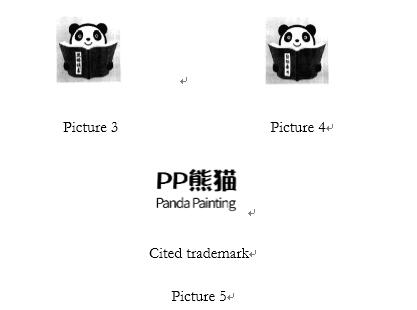
Recently, the Beijing Huanxiang Zongheng Company’s “Panda Reads Book” and “Panda Sees Book” trademark refusal review administrative litigation was trialed at Beijing Intellectual Property Court. The first-instance trial supported the litigation request of the plaintiff. The court ruled that the plaintiff’s “Panda Reads Book” trademark did not constituted similarity with the cited trademark that contained the element of “Panda”.
Case Review:
The plaintiff, Beijing Huanxiang Zongheng Company applied for the application of no. 17432853 “Panda Reads Book and Picture” (Appendix 1), no. 17432857 “Panda Reads Book and Picture” (Appendix 3), and no. 17432850 “Panda Sees Books and Picture” trademark (Appendix 4). The State Trademark Office and the Trademark Review and Adjudication Board made the following decision: the applied trademark and the cited trademarks (Appendix 2 & 5) both contain “Panda” element in their primary distinguishing component and constituted similar trademarks used on similar products or services. The registration of other trademarks has different circumstances from this case and cannot be used as the proof for the registration of the applied trademark.
The plaintiff is not satisfied with the ruling and filed an administrative litigation to Beijing Intellectual Property Court.
Court Trial:
The court partially accepted the suggestion of the attorney of the plaintiff and ruled as followed: Although the applied trademark and the cited trademarks all contained “Panda” texts and picture, panda itself could not read a book and the originality of the applied trademark is significant. The combination of “Panda” and other components made the applied trademark significantly different from the cited trademarks in terms of meaning, presentation, and visual effect. Panda was a well-known animal in the natural world, as well as a common material in trademark designing. There were many priorly registered trademarks, such as “Panda Box”, “Panda Every Day”, “Panda Learns Characters”, and “Run Panda Run”. Also, objectively, the relevant public would not confuse all trademarks of panda together.
The first-instance court cited the Supreme People’s Court (2009) Min San Zhong Zi No. 3 Civil Ruling: “The actual value of trademark is to distinguish the source of product but not to allow trademark owner to exclusively own specific symbols.” This meant that the cited trademarks could not monopolize panda materials and sources in trademark designing, simply because they contained “Panda” texts and pictures. Therefore, the simultaneous presence of the applied trademark and the cited trademarks would not cause confusion among the relevant public and they did not constitute similar trademarks. In the end, the court ruled that the Trademark Review and Adjudication shall make new refusal review decision.
Comment:
1. Publicly well-known element is public resource and the right of use shall be equally applied
In trademark design, it is common to add publicly well-known elements, such as naturally existent things, as component of the trademark. Through the rulings of the three cases above, under the circumstances that certain naturally existent thing has been used in the registered application of another party, the posterior trademark applicant shall not be denied the right on the ground that the applied trademark contains the same element as the prior trademark. Panda is an objectively existent things in the natural world and is well-known publicly. The plaintiff’s use of panda element as a component of the trademark when designing is an appropriate use of public resource. It is inconsiderate to use a certain publicly well-known element as the standard of similar trademarks and of whether or not they would cause confusion of the relevant public. This would also oppose the legislative intention of the Trademark Law to protect trademark rights.
2. From the perspective of the trademark applicant, the applicant’s central interests receive proper protection
Since trademark, an intangible property of the business, plays a pivotal role in management, effective management of the central trademark is particular advantageous for developing brand influence. “Panda” trademark series is one of the central trademarks of the plaintiff. Since their introduction, the “Panda Reads Book” app and the “Panda Sees Book” app, through the continuous and effective management, have accumulated a sizable user population and obtained considerable popularity and reputation. They have developed the corresponding market dimensions.
Apart from the three cases above, another case of the plaintiff of the same series, the no. 17432846 “Panda Reads and Picture” trademark refusal administrative litigation, has also obtained the support from the court for the litigation request. Until now, the “Panda” trademark series of the plaintiff has been confirmed by the court to be registered and used as trademarks. This provided strong support for the use of the symbols of the “Panda Reads Book” app and the “Panda Sees Book” app of the plaintiff. Meanwhile, the market dimensions and order created by the use of the products of the plaintiff received proper protection as well.
The partner and senior lawyer of Beijing Janlea Law Firm, Xu Jin, led the legal service team and provided the complete legal service for Beijing Huanxiang Zongheng Company in this case.
Appendix:

